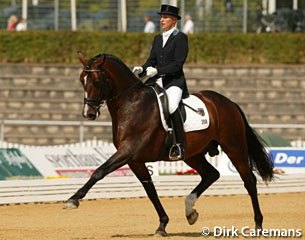
What is it that makes a young horse special? What does it take to get a young horse to Grand Prix, and how many out of the ones that make it to GP will be international stars? Finding and training a top young horse is something that is of great importance and interest to the entire dressage world.
I set out to ask our world's best, one by one, about the young horse. How many out of how many are exceptional? What to look for? When can you know the horse is not just going to make GP, but will go on to compete at an international level?
First off the rank and daughter of my childhood hero, Ingrid Klimke has 12 horses at her stable near Munster in Germany. However not all of them are on their way to GP dressage. "Half of the horses in training are dressage and the other half are eventing horses," said the 44-year old.
Taking the lead on day one of the eventing dressage in London, Ingrid's love of both eventing and dressage gives her a definite competition edge and makes her stable a particularly interesting one in terms of young horses.
"Training young horses is the fun and interesting and exciting part," she said. "Each horse is a different character and you have to keep them happy and proud, while still working hard over years."
Dedicating her life to riding and training horses, Ingrid has loved being part of many young horses' lives as they journey all the way to GP, but says one horse was particularly enjoyable.
"Damon Hill was the most talented and willing horse I have ever brought up to be a Grand Prix winner."
 So how to pick that super young star?
So how to pick that super young star?
"Looking for a young horse to go to GP, I focus on the hind legs, the construction of his body for sitting on his haunches, lightness in the contact, smartness and intelligence. He must have 3 more than just good gaits, and his health must be strong."
Ingrid can't guess at a particular ratio of young horses that will make it all the way to GP, but she knows that a lot of it comes down to the training.
"If they stay healthy and have the talent for the piaffe and passage and collection, you as the rider have to make them."
While GP is a test for even the most talented of horses, Ingrid says the most difficult aspect of the Grand Prix "depends entirely on the horse" but there are certain aspects that can greatly increase a young hors'es chances.
"If a horse wins at the young horse competitions does it usually mean he will be a success in GP level," she asked rhetorically. "While you may see the talent early, to make it to GP you have to take it year by year, to develop the right muscles and give each young horse a chance to learn all the movements with patience and fun. For Grand Prix the piaffe and passage are really the most important thing."
I wondered then, what is the most common reason a young horse would fail to reach GP?
"No talent for it," Klimke said firmly. "Bad hind legs, conformation problems."
So, once you have chosen a top young horse with good gaits and the hind action and conformation, Klimke said the age of 6 is when can you tell that the young horse might go all the way.
 "6 at the latest, if I have had him since he was 4, and his schooling was correct."
"6 at the latest, if I have had him since he was 4, and his schooling was correct."
So while we may be captivated by the expression of an amazing two year old, Ingrid says it's not until the actual training begins that she can know the horse's true potential.
"I first need to sit on the horse, I need to feel it. But I cannot tell at two years old if the horse will make it."
Typically beginning the lateral work at around 5 and then moving up one more level every year from then on, Ingrid believes there is no one way to train a young horse, or one particular time frame to work with.
"The horse tells you what they need! It totally depends on the temperament and quality of each and every horse!"
by Sarah Warne
Photos © Astrid Appels - Dirk Caremans
Related Links
Ingrid Klimke: Where Riding Becomes Art
Horse-friendly Dressage Training with Klimke and Thomsen: Desensitise and Motivate